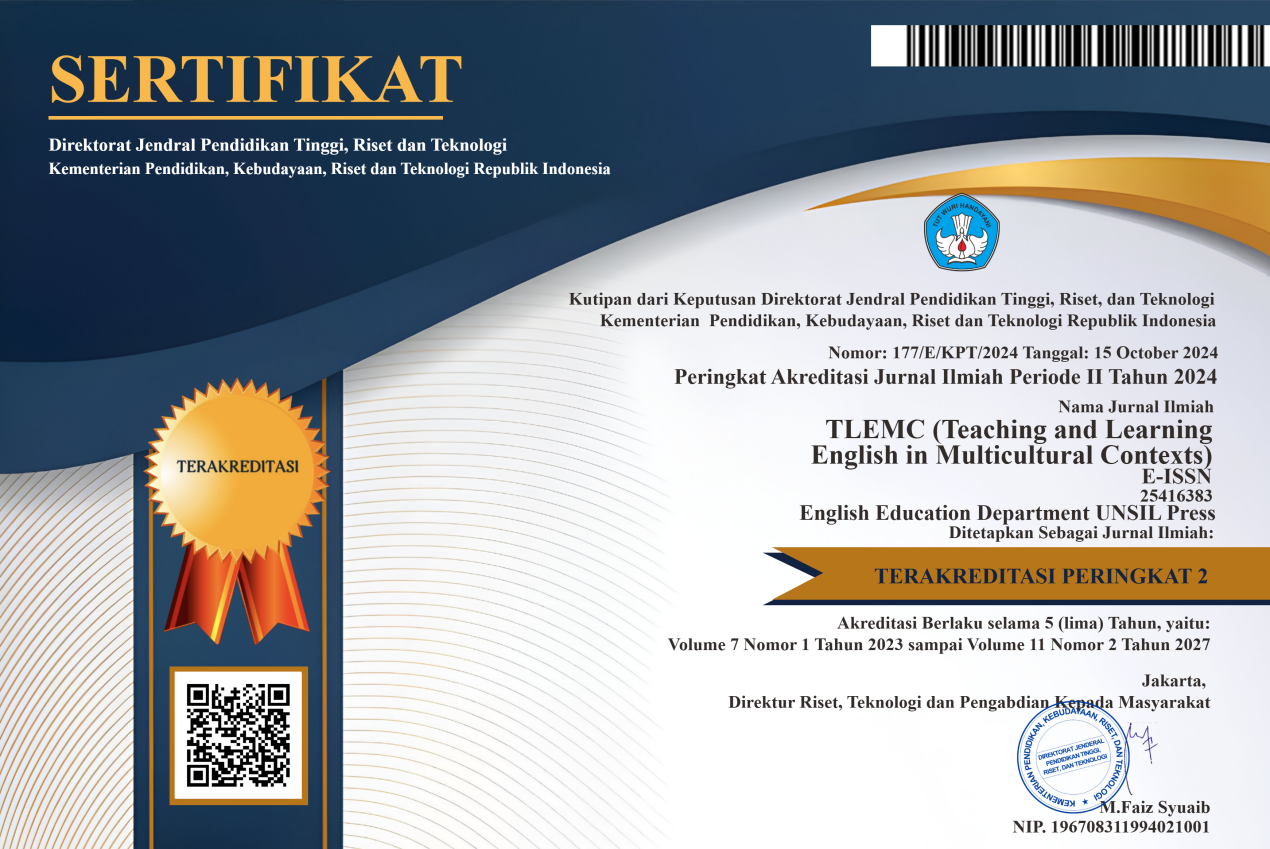Skype as a Synchronous Online Platform in EFL Class
Abstract
The COVID-19 pandemic has had an impact on various fields including education. The learning process shifted from face-to-face learning to distance learning. Skype is one of the platforms that is used in one of the universities in Indonesia as a medium for online learning during a pandemic situation. Therefore, this study investigated students’ perceptions of the use of Skype as a platform for synchronous online learning because. To collect the data, this study conducted interviews with three participants from the English Education Department in one of the universities in Indonesia that use Skype as a medium for online learning during the pandemic situation one semester. The data were analyzed using thematic analysis from Braun and Clarke (2006). Underpinning Technology Acceptance Model (TAM) framework, this qualitative research documented positive perceptions toward the use of Skype based on two factors: perceived ease of use and perceived usefulness. The findings reported that there are two big themes in this research: Skype facilitates users to adapt easily and the Effectiveness of Skype application as an online learning tool.
Â
Keywords: EFL class, online platform, skype, synchronous.
Full Text:
PDFReferences
Altman, S., Valenzi, E., & Hodgetts, R. M. (1985). Organizational Behavior: Theory and Practice. Orlando, Florida: Academic Press, Inc
Arani, J. A. (2018). Advancing Academic Writing in a Mobile Skype-Based Blended Model. International Journal of Interactive Mobile Technologies, 12(3), 86-103.
Atwater, C. R., Borup, J., Baker, R. E., & West, R. (2017). Student Perceptions of Video Communication in an Online Sport and Recreation Studies Graduate Course. Sports Management Education Journal, 11(1), 3-12.
Banna, J., Lin, M.-F. G., Stewart, M., & Fialkowski, M. K. (2015). Interaction Matters: Strategies to Promote Engaged Learning in an Online Introductory Nutrition Course. Journal of Online Learning and Teaching, 11(2), 249–261.
Blaine, A. M. (2019). Interaction and Presence in the Virtual Classroom: An Analysis of The Perceptions of Students and Teachers in Online and Blended Advanced Placement courses. Computers and Education, 31–43. https://doi.org/10.1016/j.compedu.2019.01.004
Carswell, A. D., & Venkatesh, V. (2002). Learner Outcomes in an Asynchronous Distance Education Environment. Human-Computer Studies, 56, 475–494. https://doi.org/10.1006/ijhc.1004
Davis, F. D. (1989). Perceived Usefulness, Perceived Ease of Use, and User Acceptance of Information Technology. MIS Quarterly: Management Information Systems, 13(3), 319–340. https://doi.org/10.5962/bhl.title.33621
Davis, F. D., Bagozzi, R. P., & Warshaw, P. R. (1989). User Acceptance of Computer Technology: A Comparison of Two Theoretical Models. Management Science, 35(8), 982–1003. https://doi.org/10.1287/mnsc.35.8.982
Eaton, S. E. (2010). Using Skype in the Second and Foreign Language. Get Your ACT(FL) Together Online: Standards Based Language Instruction via Social-Media, 1–14.
Fahlevi, P., & Dewi, A. O. P. (2019). Analisis Aplikasi Ijateng Dengan Menggunakan Teori Technology Acceptance Model (TAM). Jurnal Ilmu Perpustakaan, 8(2), 103–111.
Fedic, D., & Krelova, K. K. (2015). Skype-based Educational Method: Experiences in Language Learning. International Conference on Humanities, Literature and Management (ICHLM'15). https://doi.org/10.15242/icehm.ed0115094
Ghazal, S., Samsudin, Z., & Aldowah, H. (2015). Students’ Perception of Synchronous Courses using Skype-based Video Conferencing. Indian Journal of Science and Technology, 8(1), 1–9. https://doi.org/10.17485/ijst/2015/v8i30/84021
Granda, J. C., Nuño, P., Suárez, F. J., & Pérez, M. A. (2013). E-pSyLon: A synchronous e-learning platform for staff training in large corporations. Multimedia Tools and Applications, 66(3), 431–463. https://doi.org/10.1007/s11042-012-1061-9
Hill, J. R., Song, L., & West, R. E. (2009). Social Learning Theory and Web-Base Learning Environments: A Review of Research and Discussion of Implications. The American Journal of Distance Education, 23(2), 88-103.
Irfan, M., Kusumaningrum, B., Yulia, Y., & Widodo, S. A. (2020). Challenges During the Pandemic: Use of E-Learning in Mathematics Learning in Higher Education. Infinity Journal, 9(2), 147. https://doi.org/10.22460/infinity.v9i2.p147-158
Kaklamanou, D., Pearce, J., & Nelson, M. (2012). Food and Academies: A Qualitative Study. Department for Education, 1-23.
Krishnapatria, K. (2020). From “Lockdown†to Letdown: Students’ Perception of E-learning amid the COVID-19 Outbreak. ELT in Focus, 3(1), 1–8.
Landry, B. J. L., Griffeth, R., & Hartman, S. (2006). Measuring Student Perceptions of Blackboard Using the Technology Acceptance Model. Decision Sciences Journal of Innovative Education, 4(1), 87–99. https://doi.org/10.1111/j.1540-4609.2006.00103.x
Layali, K., & Al-Shlowiy, A. (2020). Students’ Perceptions of E-Learning for Esl/Efl in Saudi Universities At Time of Coronavirus: a Literature Review. Indonesian EFL Journal, 6(2), 97. https://doi.org/10.25134/ieflj.v6i2.3378
Lee, D. Y., & Lehto, M. R. (2013). User Acceptance of YouTube for Procedural Learning: An Extension of The Technology Acceptance Model. Computers and Education, 61(1), 193–208. https://doi.org/10.1016/j.compedu.2012.10.001
Little, B. B., Passmore, D., & Schullo, S. (2006). Using synchronous software in Web-Based Nursing Courses. CIN: Computers, Informatics, Nursing, 24(6), 317-325. Retrieved from http://journals.lww.com/cinjournal/pages/default.aspx
Liu, X. (2010). Empirical Testing of a Theoretical Extension of the Technology Acceptance Model: An Exploratory Study of Educational Wikis. Communication Education, 59(1), 52–69. https://doi.org/10.1080/03634520903431745
Ng, E., Shroff, H., R., & Lim, C., P. (2013). Applying a Modified Technology Acceptance Model to Qualitatively Analyse the Factors Affecting E-Portfolio Implementation for Student-Teachers in Field Experience Placements. Issues in Informing Science and Information Technology, 10, 355–365. https://doi.org/10.28945/1816
Male, H., Murniarti, E., Simatupang, M., Siregar, J., Sihotang, H., & Gunawan, R. (2020). Atittude of Undergraduate Student’S Towards Online Learning During Covid-19 Pandemic. Palarch’s Journal of Archaeology of Egypt / Egyptology, 17(4), 1628–1637.
Marpa, E. P. (2020). Technology in the Teaching of Mathematics: An Analysis of Teachers’ Attitudes during the COVID-19 Pandemic. International Journal on Studies in Education, 3(2), 92–102. https://doi.org/10.46328/ijonse.36
Martin, F., Parker, M. A., & Deale, D. F. (2012). Examining interactivity in synchronous virtual classrooms. International Review of Research in Open and Distance Learning, 13(3), 228–261. https://doi.org/10.19173/irrodl.v13i3.1174
Martin, J. (2019). Building Relationships and Increasing Engagement in the Virtual Classroom: Practical Tools for the Online Instructor. Journal of Educators Online, 16 (1).
Mohd Noor, K. B. (2008). Case Study: A Strategic Research Methodology. American Journal of Applied Sciences, 5(11), 1602–1604.
Mtawa, Y. Al, Haque, A., & Bitar, B. (2018). Does Internet of Things Disrupt Residential Bandwidth Consumption? IEEE Vehicular Technology Conference, 2018-August, 1–5. https://doi.org/10.1109/VTCFall.2018.8690652
Newmann, F. M., Wehlage, G. G., & Lamborn, S. D. (1992). The Significance and Sources of Student Engagement. Student engagement and achievement in American secondary schools (pp. 11–39). New York, NY: Teachers College Press.
Ogden, C. D. (2015). Skype as a Scaffolding Tool for Underprepared Freshmen English Composition Students. Walden Dissertations and Doctoral Studies. https://scholarworks.waldenu.edu/dissertations/523
Pratama, H., Azman, M. N. A., Kassymova, G. K., & Duisenbayeva, S. S. (2020). The Trend in Using Online Meeting Applications for Learning During the Period of Pandemic COVID-19: A Literature Review. Journal of Innovation in Educational and Cultural Research, 1(2), 58–68. https://doi.org/10.46843/jiecr.v1i2.15
Purnomo, M. (2017). Student’s Perceptions on Simulation as Part of Experiential Learning in Approaches, Methods, and Techniques (AMT) Course. Language and Language Teaching Journal, 20(01), 30–39. https://doi.org/10.24071/llt.2017.200104
Rahayu, F. S., Budiyanto, D., & Palyama, D. (2017). Analisis Penerimaan E-Learning Menggunakan Technology Acceptance Model (Tam) (Studi Kasus: Universitas Atma Jaya Yogyakarta). Jurnal Terapan Teknologi Informasi, 1(2), 87–98. https://doi.org/10.21460/jutei.2017.12.20
Raja, R., & Nagasubramani, P. (2018) Impact of Modern Technology in Education. Journal of Applied and Advance Research, 33-35.
Ramdhani, M. A., & Muhammadiyah, H. (2015). The Criteria of Learning Media Selection for Character Education in Higher Education. International Conference of Islamic Education in Southeast Asia, 174–182.
Romney, Marshall B., Steinbart, Paul John. (2004). Accounting information system: sistem informasi akuntansi (1) (Ed. 9, Buku 1). Jakarta: Salemba Empat.
Sadikin, A., & Hamidah, A. (2020). Pembelajaran Daring di Tengah Wabah Covid-19. Biodik: Jurnal Ilmiah Pendidikan Biologi, 6(2), 109–119. https://doi.org/10.22437/bio.v6i2.9759
Salbego, N. N., & Tumolo, C. H. S. (2015). Skype TM Classes: Teachers and Students’ Perceptions on Synchronous Online Classes in Relation to Face-to-face Teaching and Learning. International Journal of Language and Applied Linguistics, 1(3), 36–45.
Sargeant, J. (2012). Qualitative Research Part II: Participants, Analysis, and Quality Assurance. Journal of Graduate Medical Education, 4(1), 1–3. https://doi.org/10.4300/jgme-d-11-00307.1
Slameto. (2003). Belajar dan Faktor-faktor yang mempengaruhinya. Jakarta: Rineka Cipta.
Smith, C.A., Hoderi, M., & Mcdermott, W. (2019). A Preliminary Study of Students Perception and Learning from Different Delivery Methods. The Academy of Educational Leadership Journal, 23(2).
Turner, M., Kitchenham, B., Brereton, P., Charters, S., & Budgen, D. (2010). Does the Technology Acceptance Model Predict Actual Use? A Systematic Literature Review. Information and Software Technology, 52(5), 463–479. https://doi.org/10.1016/j.infsof.2009.11.005
United Nation. (2020). Startling disparities in digital learning emerge as COVID-19 spreads: UN education agency. Retrieved from: https://translate.google.co.id/?hl=id&sl=en&tl=id&text=Startling%20disparities%20in%20digital%20learning%20emerge%20as%20COVID-19%20spreads%3A%20UN%20education%20agency&op=translate
Venkatesh, V., & Davis, F. D. (2000). Theoretical Extension of the Technology Acceptance Model: Four Longitudinal Field Studies. Management Science, 46(2), 186–204. https://doi.org/10.1287/mnsc.46.2.186.11926
Widyanti, A., Hasudungan, S., & Park, J. (2020). E-Learning Readiness and Perceived Learning Workload Among Students in an Indonesian University. Knowledge Management and E-Learning, 12(1), 18–29. https://doi.org/10.34105/j.kmel.2020.12.002
Yen, Y. C., Hou, H. T., & Chang, K. E. (2015). Applying Role-Playing Strategy to Enhance Learners' Writing and Speaking Skills in EFL Courses Using Facebook and Skype as Learning Tools: A Case Study in Taiwan. Computer Assisted Language Learning, 28(5), 383-406. https://doi.org/10.1080/09588221.2013.839568
Yıldız, E., Sarıtaş, M. T., & Can ŞENEL, H. (2015). Examining the Attitudes and Intention to Use Synchronous Distance Learning Technology among Pre-service Teachers: A Qualitative Perspective of Technology Acceptance Model. American Journal of Educational Research, 3(10A), 17–25. https://doi.org/10.12691/education-3-10a-3
Yin, R. K. (2017). Case study research and applications: design and methods. (Sixth Edition). Los Angeles: SAGE.
Young, J. C., Rose, D. C., Mumby, H. S., Benitez-Capistros, F., Derrick, C. J., Finch, T., Garcia, C., Home, C., Marwaha, E., Morgans, C., Parkinson, S., Shah, J., Wilson, K. A., & Mukherjee, N. (2018). A Methodological Guide to Using and Reporting on Interviews in Conservation Science Research. Methods in Ecology and Evolution, 9(1), 10–19. https://doi.org/10.1111/2041-210X.12828.
DOI: https://doi.org/10.37058/tlemc.v4i2.6980
Refbacks
- There are currently no refbacks.
INDEXED BY:
This work is licensed under a Creative Commons Attribution-NonCommercial-ShareAlike 4.0 International License.
![]()
TLEMC (Teaching and Learning English in Multicultural Contexts)
Program Studi Pendidikan Bahasa Inggris
Fakultas Keguruan dan Ilmu Pendidikan
Universitas Siliwangi
Jl. Siliwangi No. 24 Kota Tasikmalaya - 46115
email: tlemc@unsil.ac.id





